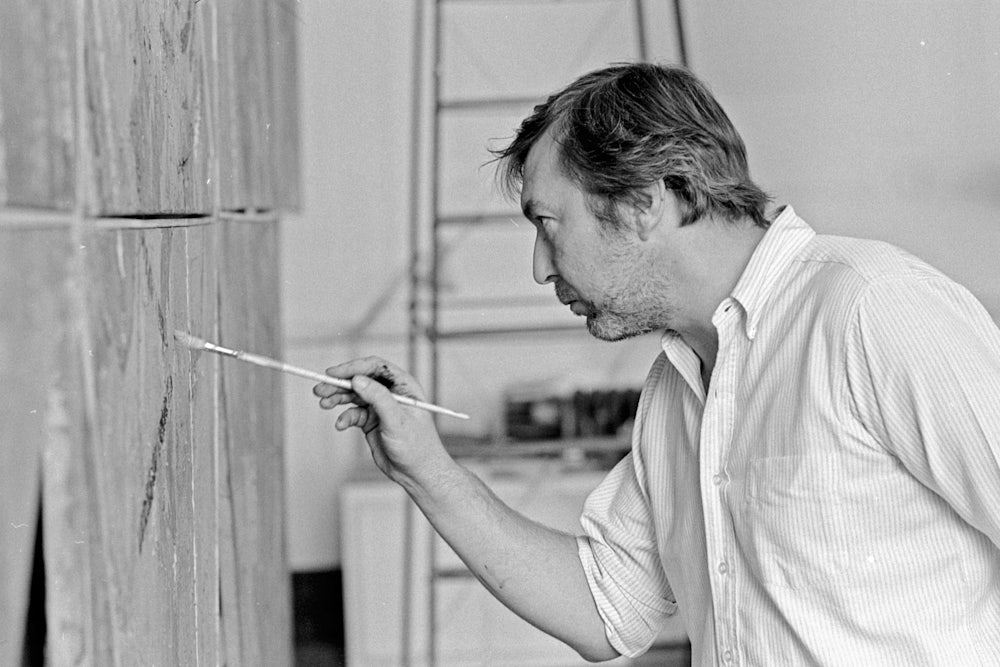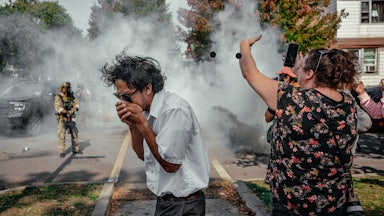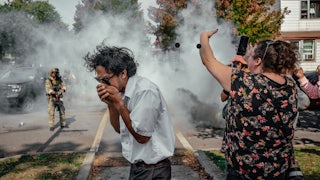Jasper Johns cultivates the same gloomily ambiguous mood in just about every painting in the huge survey of his work that is at the Museum of Modern Art until January 21. These canvases are about stalemates and dead-ends and insoluble puzzles; they’re headaches waiting to happen. Over and over again Johns replays the same old Dadaist is-it-art-or-not? routines, until the everything-is-nothing mantra has turned your mind to mush. Johns’s white-on-white Maps are unreadable, his numbers blend one into the other, and when he paints the seasons he gives spring and summer the same murky chill as autumn and winter. This artist’s craftsmanlike punctiliousness only serves to give his negativity a distinguished patina. His idea of fine finish is a few nihilistic grace notes: a solitary drip here, a blackish smudge there. The retrospective surveys a forty-year-long funk.
Kirk Varnedoe, the Chief Curator of Painting and Sculpture at the Modern, has organized the show himself, rather than delegating the job to one of his lieutenants. He loves Johns’s frosty-Olympian Dadaist forays. He may think that Johns’s sourness is what museum-quality art is all about, but his support is not a selfless act. Varnedoe knows that there is peril in presiding over a great collection of early modern paintings when he also wants to dominate a postmodern scene that is inclined to regard all painting as irrelevant. Johns, who is both a Dadaist and a nearly universally admired painter, can function as the master of detente. And detente is what Varnedoe needs.
Marcel Duchamp is the ghost who stares out from every painting and sculpture and drawing in the show. Johns knew Duchamp in the ‘60s, and his own polished persona may in some respects be modeled on the likable aspects of Duchamp, who could appear a paragon of bohemian taste, elegance and unflappability as he followed all the new developments in New York right up until the time of his death in 1968. Johns may want us to think of Duchamp as an august historical figure, but what he and his friends saw behind the facade of the impeccable aesthete was an incendiary genius whose anti-art apercus could be accepted as law precisely because they came from the lips of a man of such vast sophistication. In an interview in 1966, Duchamp dismissed Andre Breton, the poet and polemicist of Surrealism, as “a man of the ‘20s, not completely rid of notions of quality, composition, and the beauty of materials.” The point was that Duchamp was a man of the present who had escaped from all those outmoded ideas.
If Johns sometimes looks likes Duchamp’s truest disciple, it is because he trumped the old aesthete’s rejection of the idea of beauty by resurrecting “notions of quality, composition, and the beauty of materials” as parodistic imitations. Johns’s slurpy surfaces are a send-up of paint quality, just as his what-you-see-is-what-you-get subjects are send-ups of subject matter. By now Johns is such a pervasive influence that it is sometimes difficult for people to separate his send-ups from the real thing, but that is a confusion that Kirk Varnedoe seems to welcome. In an essay in the catalog he explains that Johns has helped him to see that one can unite Duchamp’s Dadaism and “the more traditional mainstream lineage of Cézanne and Picasso.” These artists might have once appeared “antithetical” and “incommensurable,” but after Varnedoe looked at Johns’s work he understood that all of this “can be grafted together ... to produce a hybrid of potent fertility.” Johns is a hybrid, all right, but I’m not so sure about the potent fertility.
Nothing in this retrospective is what it seems, and this conundrum is supposed to keep us on our toes. In 1959, Johns stenciled the word “yellow” on a painting in blue letters, and the confusion delighted him so much that he’s done the same thing over and over; a recent canvas has the word “red” written (this time backwards) in gray. Johns doesn’t go anywhere with this paradox. He lacks the mastery of color that might enable him to give a gray the rousing heat of a red. Maybe he just wants us to mull over our confounded expectations. After Duchamp died, Johns wrote that the older artist “declared that he wanted to kill art (`for myself’) but his persistent attempts to destroy frames of reference altered our thinking, established new units of thought.” Does Johns imagine that his mismatched colors and words signify a new unit of thought? Johns has said of one of his white paintings of a flag that he meant to create something that was “neither a flag nor a picture. It can be both and still be neither.” That has a nice enigmatic twang, but what does it mean?
The contemporary art audience will generally take a crack at a puzzle, even if there is reason to suspect that no solution exists. The challenge for the artist is to keep people’s attention after the initial novelty has worn off, and certainly Johns is some kind of genius when it comes to weaving and reweaving his phony-baloney spells. His manipulative savvy can sometimes bamboozle even more discriminating museumgoers, since he bases his effects on a close study of the way that other—mostly better—artists have managed to grab the audience. Johns will take a nifty method of handling paint from de Kooning, a dazzling image from Picasso. He provides something for everybody: a bit of trompe-l’oeil virtuosity for collectors who want their money’s worth, a little porn for younger artists who might suspect that Johns has lost his edge.
Johns’s work does have a certain fidgety elegance. But his effects are so drearily localized that the refinements close down a picture instead of pulling us into a world that has an integrity all its own. He probably wants it this way, but those who want something different are perfectly justified in rejecting not only the product but also the approach. This artist moves around bits of pigment as if painting were some kind of post-Armageddon game, like Duchamp at his chessboard. It’s easy to argue that Johns has rescued the dying embers of a vanishing art, as long as you ignore the fact that he stood by applauding while his hero poured the gasoline and lit the match.
Johns, who is 66, emerged at a sea-change moment in American art. In the late 1950s, success was coming to the generation that arrived in New York after the war and watched as Pollock and de Kooning achieved national and then international fame. Much good work was being done, but there was also talk of Abstract Expressionism turning into a new academy. With galleries and museums responding to the enthusiasm of a rapidly growing audience, there were beginning to be signs that the public’s appetite for innovation might eventually outstrip whatever surprises the artists had to offer. All of these developments peaked with the Pop explosion of 1962, but already in 1958, when Johns showed the paintings of flags and targets that he had been doing since the mid-’50s at the fledgling Leo Castelli Gallery, there were signs of discontent. People wanted change, and in Johns they found just enough. If his readymade subject matter had a startling Dadaist impudence, his rugged-but-elegant surfaces seemed to prove that there was life left in Abstract Expressionism.
This work was an immediate success when it was shown in 1958. Alfred H. Barr Jr., the founding director of the Museum of Modern Art, earmarked four paintings for the museum’s permanent collection, thereby beginning an institutional relationship that has culminated thirty-eight years later with the current retrospective. And Thomas B. Hess, the editor of Artnews and one of de Kooning’s most loyal supporters, reproduced a Johns Target on the cover of his magazine. This was an amazing response to an artist’s first show. Perhaps even more remarkable is the fact that all these years later people who care little for Dadaism and still less for Pop keep a warm place in their hearts for those first Flags and Targets. Even many skeptics want to give Johns some credit for having fussed so mightily over the Flags. The artist would cut his stars out of newspaper, glue them down, then wash over some milky, translucent paint (it’s encaustic, a wax medium). There’s lots of detail involved—close work, I guess you’d call it. Johns worries over those surfaces, inch by inch, but this is basically an amateur’s idea of technique, since it has no cumulative impact.
With those first Flags, Johns turns an American icon into his own kind of thingamajig, and if that’s not saying much, it’s more than I can say for the rest of the work in the show. In the ‘60s, when Johns tried his hand at big horizontal works with lots of heterogeneous elements, such as According to What, he couldn’t even achieve the vapid decorative sweep that his old friend Rauschenberg was bringing to oversized surfaces. And there is always trouble when he introduces collage elements (another Rauschenberg specialty). Johns is far too intent on keeping everything under control to allow for the explosive metaphoric possibilities of assemblage. The painted body parts in the early Target with Plaster Casts (1955) and the broom in Fool’s House (1962) look feeble and pretentious. I can’t imagine a worse combination.
Johns is also too much of a control freak to let loose with the possibilities of paint. When his work goes abstract in what are known as the cross-hatch paintings (they dominate the ‘70s) he leaves us with practically nothing to look at, because there is no feeling for color to give some dynamism to his broken patterns of parallel lines. Johns supplies these abstractions with fancy metaphoric titles such as Scent, Corpse and Mirror, Dancers on a Plane, and Between the Clock and the Bed. Nothing in Johns’s work goes unanalyzed, and museumgoers who are disposed to work out the metaphors can certainly get their minds spinning. The Barber’s Tree from 1975 is apparently based on a photograph that Johns saw in National Geographic, which showed a Mexican man concocting a sort of barber’s pole by painting stripes on a tree. Michael Crichton, the author of the catalog of Johns’s 1977 retrospective at the Whitney, reproduces this photograph and observes that “it was probably the underlying idea of painting over reality that interested Johns.” Oh, of course, painting over reality. For an artist who’s already painted over the North American continent in his Maps, painting over reality is just the next cosmic leap.
When you see the cross-hatched paintings in this big retrospective, where they mark roughly the halfway point, they look like Johns’s way of putting some distance between his Pop-oriented beginnings and the painter-philosopher that he has always wanted to become. Viewed this way, the cross-hatch paintings provide the perfect lead-in to the work of the ‘80s, in which Johns attempts to situate himself among the immortals by crowding his paintings with references to Grunewald, Leonardo, Picasso and, later, Holbein and Cézanne. Johns presents these snippets from the masters in the same deadpan spirit as he once presented the icons of the American heartland. His art-historical potpourri has no particular logic, but he insists on his quotations with his trademark cool belligerence, so that you can scarcely believe that they really mean this little. Over and over, he reproduces the outlines of several fallen soldiers from Grunewald’s Resurrection. And two Picassos from 1936, Woman in a Straw Hat and The Minotaur Moving His House, crop up more than once, as does a skeletal figure from his 1958 Fall of Icarus.
Johns’s admirers know their art history, and in his recent work they imagine that they are seeing a replay of the mysterious process by which a very great artist sometimes becomes most himself when he quotes almost line by line from a work that he passionately admires. This extraordinary phenomenon cannot be willed into being, yet some of our postmodern painters are so tired of the present that they would just as soon pretend that they’re immolating themselves on the altar of the past: it’s the nouveautraditional thing to do. Meanwhile the critics offer specific explanations for some of Johns’s alleged acts of selfimmolation. We are told, for example, that a fragment from Picasso’s Minotaur Moving His House first appeared as an element in the Seasons of 1985-86 because Johns was changing his address. That’s perfectly logical, but it says nothing about the impact of the quotation in the work.
When Picasso salutes Ingres, he’s re-experiencing the magisterial academician’s sensuous arabesques in terms of his own feeling for line and color; each stroke is a sympathetic response. Johns just copies elements: a few outlines here, a complete image there. He treats great paintings as an art director might. He crops and edits, cuts and pastes. His canvases are message boards, sometimes literally so, as in Racing Thoughts (1983), in which a silkscreen reproduction of the Mona Lisa is affixed to a bathroom wall by several trompe-l’oeil bits of tape. He notes down things he likes, and personalizes them with a little joke, as in a recent series of tracings, done on clear plastic, after a reproduction of one of Cézanne’s Bathers. Any art student ought to know that a tracing of a painting isn’t a response or an interpretation; and even the Dadaist sex-change operation involved in turning one of Cézanne’s women into a man with an erection hardly registers amid Johns’s lackluster washes of sepia-toned ink.
In the paintings that are gathered in the final room of the show, bits of Picasso and Grunewald are combined with floor plans that are said to represent a house in which Johns lived as a child. Here he is supposed to be in one of his meditative moods, a sort of fugue state in which art history and personal history begin to merge. This man whose idea of an homage is to do tracings after Cézanne is trying to convince us that he is keeping the high art tradition alive. Johns’s tamped-down palette doesn’t achieve the twilit poetry that he’s probably after, but the gun-metal color scheme does put us on notice that this is sober work. The most recent canvases are meant to convey an impression of middle-aged maturity, lessons learned, challenges met. These high-priced gray paintings are the art-world equivalent of a very expensive gray suit. They are engineered for importance.
Some people say that Jasper Johns has been making an impression for so long that by now he’s beyond the reach of criticism. Michael Kimmelman explained in his review of the Johns show in The New York Times that he doesn’t care for a lot of the work, but he also observed that “it’s pointless to argue about Mr. Johns’s place in history; this issue was settled decades ago.” By reassuring his readers that Johns really is an important artist, Kimmelman may intend to soften his own discomfort at finding himself on the wrong side of current taste. When Kimmelman concedes Johns his “place in history,” however, he’s jumping the gun. The idea that an artist who has been acclaimed for thirty-five years is a permanent fixture reflects a shortsighted view of history. Johns’s long relationship with the Museum of Modern Art proves nothing except that he is the closest thing to an official artist that we have, and that doesn’t prove much at all.
There are official artists, such as Velázquez, whom we count among the immortals. And there are official artists, such as Le Brun, who dominated France in the second half of the seventeenth century, filling Versailles much as Johns now fills the Modern, who hardly count with anybody today. Artists are hailed in one generation and forgotten two or three generations later. I wonder if Johns recalls an observation that his friend Duchamp made in 1966: “Success is just a brush fire, and one has to find wood to feed it.” Kirk Varnedoe has thrown on lots of wood, and the fire is burning furiously. This huge retrospective is the ultimate accolade that Johns will receive from his contemporaries. And in the heat of MoMA’s fire it’s easy to forget that what remains after the flames die down is another matter entirely.






